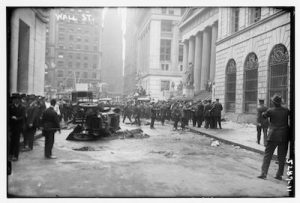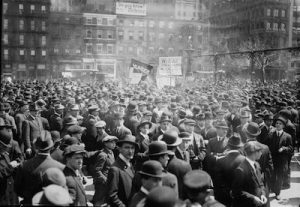Communiqué
AMERICAN EXPERIENCE “The Bombing of Wall Street” Premieres Tuesday, February 13
< < Back toNew Film Explores the Radical Movement that Led to a Mostly-Forgotten Terror Attack on U.S. Soil and Launched the Career of J. Edgar Hoover
On September 16, 1920, as hundreds of Wall Street workers headed out for lunch, a horse-drawn cart packed with dynamite exploded in front of Morgan Bank — the world’s most powerful banking institution. The blast turned the nation’s financial center into a bloody war zone and left 38 dead and hundreds more seriously injured. As financial institutions around the country went on high alert, many wondered if this was the strike against American capitalism that radical agitators had threatened for so long. A mostly forgotten act of terror that remains unsolved today, the bombing helped launch the career of a young J. Edgar Hoover and sparked a bitter national debate about how far the government should go to protect the nation from acts of political violence. Based on Beverly Gage’s The Day Wall Street Exploded: A Story of America in its First Age of Terror, The Bombing of Wall Street is executive produced by Mark Samels, written and directed by Susan Bellows, and produced by Michael Rossi and Susan Bellows. The film premieres on AMERICAN EXPERIENCE Tuesday, February 13, 2018, 9:00-10:00 p.m. on WOUB.

The brutal Wall Street attack struck at a moment in history when millions of people around the globe were challenging capitalism as an economic system. The Bolshevik revolution in Russia spurred similar workers movements around the globe, including in the U.S. While the so-called Gilded Age had produced great wealth, it had also created great poverty, fracturing the U.S. into the haves and the have-nots. World War I, which had just concluded a year earlier, had been enormously profitable for capitalists, but had created economic and political divisions that would prove fertile ground for revolt.
The bombing came on the heels of a series of violent labor battles from Seattle to Boston. In April and May of 1919, 30 bombs targeting bankers and government officials were mailed to arrive on May Day. Attorney General A. Mitchell Palmer, an ambitious man with his eye on the White House, ordered the Justice Department’s Bureau of Investigation to draw up a list of possible suspects. When, a month later, a bomb — and the bomber — exploded on Palmer’s very own doorstep, followed by similar attacks in six other cities, he retaliated with a broad campaign targeting anyone connected to revolutionary organizations.
Palmer created “The Radical Division” at the Bureau and appointed an ambitious 24-year-old, J. Edgar Hoover, to run it. In its first year of operation, the unit amassed more than 200,000 files on radical activities but, to Palmer’s critics, it was not enough. He silenced them on November 7, 1919, the second anniversary of the Bolshevik Revolution, with a massive raid that resulted in the deportation of 249 Russian immigrants, including the anarchist Emma Goldman. Additional “Palmer Raids” struck across the country and suspected radicals were sent to detention centers and many more were deported.

“During this period, America was grappling with the some of the same difficult quandaries in which we find ourselves now,” said AMERICAN EXPERIENCE Executive Producer Mark Samels. “How do we protect ourselves from violent extremists who wish to harm us without violating the civil liberties of those who may have different political beliefs? There was no easy answer in 1920 and no easy answer now.”
* * *
About the Participants (in alphabetical order)
Kenneth Ackerman is an attorney and author whose books include Young J. Edgar: Hoover and the Red Scare, 1919-1920, Boss Tweed: The Corrupt Pol who Conceived the Soul of Modern New York, and The Gold Ring: Jim Fisk, Jay Gould, and Black Friday 1869.
Steve Fraser is a historian, writer, and editor. His books include Wall Street: America’s Dream Palace (2008), Every Man a Speculator: A History of Wall Street in American Life (2005) and Age of Acquiescence: The Life and Death of American Resistance to Organized Wealth and Power (2015). He has taught at Columbia University, Princeton University, the University of Pennsylvania, and New York University.
Beverly Gage is professor of 20th-century American history at Yale University and author of The Day Wall Street Exploded: A Story of America in its First Age of Terror. Her next book, G-Man: J. Edgar Hoover and the American Century, will be a biography of former FBI director J. Edgar Hoover.
James Green was a professor of history and labor studies at University of Massachusetts, Boston and the author of six books on American labor and radical movements, including Death in the Haymarket: A Story of Chicago, the First Labor Movement and the Bombing that Divided Gilded Age America.
Charles McCormick is Professor of History Emeritus at Fairmont State University and author of Hopeless Cases: The Hunt for the Red Scare Terrorist Bombers.
Bruce Watson is the author of several books including Sacco & Vanzetti: The Men, the Murders, and the Judgment of Mankind and Bread and Roses: Mills, Migrants, and the Struggle for the American Dream.

